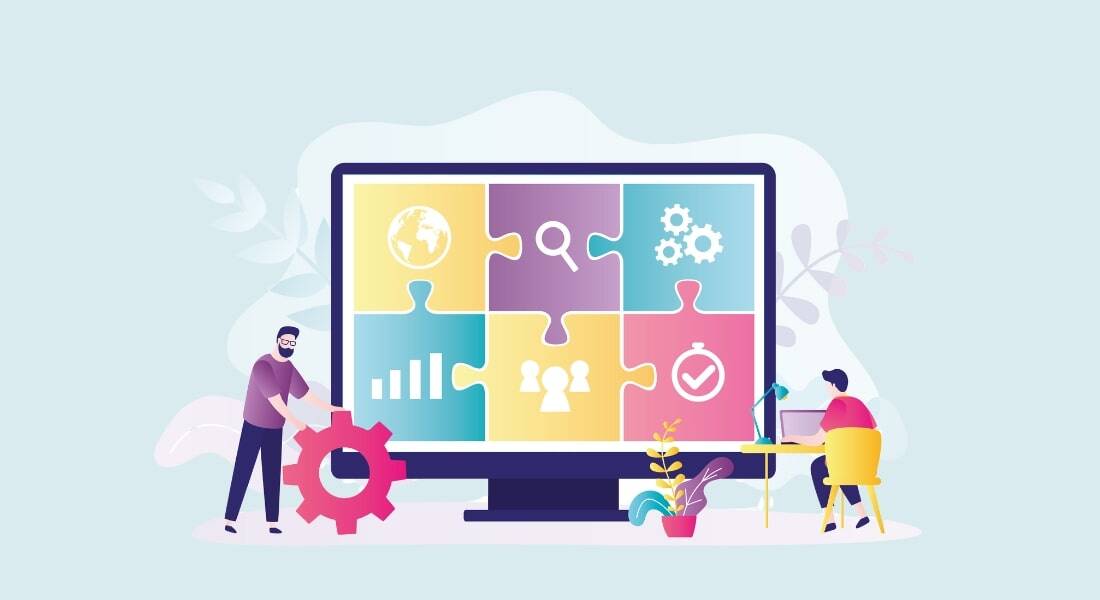A Comprehensive Guide on Microlearning for Sales and Product Training

If only turning a potential customer into a loyal client was that easy. Sadly, it’s not. Closing a deal takes a lot of effort from the sales team. It can be in terms of providing relevant information, highlighting product features, answering endless questions, discussing use cases and benefits, etc. A small hesitation or inability to deliver a proper response at any step of the process can lead to a failed deal and a lost client. So what can you do to ensure your sales and product teams are in their best shape and form? The answer is pretty simple. Provide them with engaging, impactful, relevant, and high-quality corporate training. Now, if you’re wondering how you can ensure all these elements with a single training strategy, it’s possible! By leveraging microlearning for sales and product training, you can deliver top-notch, learner-centric training to your employees. This guide will cover the A to Z of microlearning for sales and product training. So keep reading and learning! (Don’t forget to take the notes)
→ Download Now: Microlearning — Where Does It Fit in Your Learning Strategy?
Table of Contents
- What is Microlearning?
- What Are the Key Advantages of Microlearning in Corporate Training?
- What Is the Role of Microlearning in Sales and Product Training?
- What Are the Key Applications of Microlearning in Sales and Product Training?
- What Are the Different Microlearning Formats for Sales and Product Training?
- How to Implement Microlearning in Your Organization?
- How to Measure the Impact of Microlearning?
What Is Microlearning?
Microlearning is a learning approach that breaks down complex information into smaller, digestible units. This approach stands in contrast to traditional learning methods, which often involve lengthy online lectures or in-person classroom training sessions. Microlearning modules are often delivered through digital formats such as videos, interactive modules, infographics, or podcasts.

What Are the Key Advantages of Microlearning in Corporate Training?
1. Increased Learner Engagement
As we’ve seen, microlearning leverages short, focused lessons. These mini-learning nuggets are designed in a way that helps capture attention quickly and keep learners engaged. Wondering how? Well, in today's fast-paced work environments, employees are often inundated with a variety of information. This can lead to cognitive overload and stress.
Microlearning combats this by delivering bite-sized, digestible lessons that are easier to consume. Since each lesson focuses on a single topic or skill, learners can fully engage without feeling overwhelmed by excessive content. Moreover, microlearning taps into modern employees' shorter attention spans to boost participation rates and enhance learning outcomes. It leverages a variety of formats to cater to diverse learning styles and also includes multimedia and interactive components in the modules. This provides learners with the opportunity to interact with the training content instead of being mere passive receivers of the information. It fosters attention during the learning process and enhances learner engagement.

Where Does Microlearning Fit in Your Learning Strategy?
Uncover the Secrets to Crafting High-performing Micro Assets!
- What Microlearning is and What it is NOT?
- Types of Microlearning Assets
- Tips and Tools for Rapid Microlearning Development
- And More!
2. Improved Knowledge Retention
Breaking down complex information into smaller, manageable chunks can significantly promote learner engagement and improve knowledge retention. Microlearning courses capitalize on the spacing effect, a psychological phenomenon where information is more likely to be retained if presented in intervals rather than all at once.
When learners are presented with just a few key concepts at a time, they are more likely to internalize and remember the material. Repetition of these micro-lessons reinforces understanding, ensuring that learners retain knowledge for longer durations and can apply it effectively in their roles.
3. Flexibility
One of the standout advantages of microlearning is its flexibility. Unlike traditional Instructor-led Training (ILT) programs that require lengthy, scheduled sessions, microlearning can be accessed anytime, anywhere. This is particularly valuable for employees with demanding schedules, such as sales reps, customer service teams, or product specialists.
These professionals can engage with training materials during downtime, on the go, or in between tasks. Whether accessed via mobile devices, tablets, or desktops, microlearning aligns perfectly with the "learn as you go" mindset, offering convenience without sacrificing quality.
4. Cost-Effective
Microlearning significantly reduces the costs associated with traditional, in-person training programs.

Microlearning can be easily delivered through various digital platforms, including learning management systems (LMS), mobile apps, and even email. The content can be quickly updated and reused, further reducing long-term costs. This cost-effectiveness makes microlearning an attractive option for organizations looking to train employees without overextending their training budgets.
What Is the Role of Microlearning in Sales and Product Training?
Microlearning is an effective method for sales and product training. It's perfect for these roles because it can deliver information in short, focused segments that fit in with the fast pace of the job.
Featured Snippet: How Can Microlearning Benefit Sales and Product Training?
Here’s an overview:
- Simplifies Complex Information
- Supports On-Demand Learning
- Boosts Knowledge Retention
- Speeds Up Time to Competency
- Facilitates Continuous Learning
Let me explain in more detail:
1. Simplifies Complex Information
Sales reps and product specialists often need to master a wide array of details about products, services, market trends, and customer needs. This information can be complex and overwhelming when delivered in traditional, lengthy training sessions. Microlearning design breaks down these intricate topics into smaller, manageable units that focus on one concept at a time.
For example, instead of trying to grasp the entire product portfolio in one sitting, sales teams can absorb key features of a specific product in just a few minutes. This approach makes the learning process more digestible and less intimidating, allowing for quicker understanding and application.
Watch this video to know some useful tips for effective microlearning design.
2. Supports On-Demand Learning
The business world moves at an unmatchable speed. To keep pace, sales and product specialists need training that fits their schedules. For this, microlearning offers the best solution by enabling on-demand, just-in-time learning. It means that the training content can be accessed whenever and wherever it's needed.
If a sales rep has a client meeting and needs to brush up on the features of a new product, they can quickly access a short microlearning module that provides just the right information. This flexibility ensures that training doesn’t disrupt daily work activities and allows employees to refresh their knowledge as needed in real-time.
3. Boosts Knowledge Retention
Product and sales training often involves an overload of information, which can lead to rapid forgetting. Microlearning addresses this issue by offering short, targeted lessons that reinforce learning over time. Sales reps can repeatedly revisit key topics, such as product updates or sales techniques, to ensure they stay top of mind.
Regular reinforcement of critical points through microlearning helps improve long-term retention. It is essential to build the confidence to discuss products or services accurately during sales interactions and close deals successfully.
4. Speeds Up Time to Competency
New product launches or changes in sales strategies require sales teams to get up to speed quickly. The design and development of eLearning training programs can take too long and delay the time it takes for reps to reach full productivity.
However, microlearning offers a faster route to competency. That’s right! By delivering bite-sized lessons, microlearning enables the sales reps and product teams to acquire the knowledge they need to hit the ground running. Furthermore, short modules that cover specific selling points or competitive advantages enable teams to become proficient more quickly, which can lead to faster sales cycles and better performance.
5. Facilitates Continuous Learning
Sales and product training is an ongoing process due to constantly evolving products, market conditions, and customer preferences. Microlearning supports continuous learning by offering a stream of regular, relevant updates that can be integrated into a sales rep's day-to-day routine. For instance, if a product feature is updated or a new competitor enters the market, a quick microlearning module can be shared to keep the sales team informed. This ensures that reps are always armed with the latest knowledge to stay competitive and respond to client inquiries confidently.
→ Need to see these points in action? Check out our case study on leveraging microlearning for product sales training for a pharma major.
Pleased with the results? Now let’s explore all the possibilities of how you can leverage microlearning for “YOUR” sales and product training.
What Are the Key Applications of Microlearning in Sales and Product Training?
Microlearning is a great way to get targeted and efficient training solutions in various aspects of sales and product training. Let's take a closer look at some of its key applications!
1. Product Knowledge
You can use microlearning to deliver concise, focused content about product features, benefits, competitive advantages, etc. This is crucial for your sales reps who need to quickly grasp and communicate complex product details to potential customers. A closer look at the key areas related to product knowledge includes:
- Feature Highlights: Short modules can cover individual product features in detail, allowing sales reps to understand and recall specific attributes and functionalities.
- Benefits and Value Propositions: Brief, focused lessons can explain how the product solves customer problems or adds value, which is essential for persuasive selling.
- Competitive Analysis: Microlearning can present comparisons between your product and competitors, helping sales reps articulate unique selling points and handle competitive objections effectively.
For example, a sales rep could complete a 5-minute module on a new product feature, ensuring they can confidently discuss it with clients during a meeting later that day.
2. Sales Techniques
Microlearning can be instrumental in training and reinforcing effective sales techniques. You can incorporate microlearning modules to enable the sales reps to practice and refine their skills in areas critical to closing deals. Some of the common techniques and strategies where microlearning lessons can come in handy are:
- Objection Handling: Quick training segments can assist sales reps on how to address common objections and turn them into winning opportunities.
- Closing Strategies: Short, relevant courses that offer practical tips and scripts for closing sales can help sales representatives apply the strategies in real-world scenarios.
- Negotiation Skills: You can also use microlearning modules to provide training on negotiation techniques and strategies. This can include how to handle pricing discussions, contractual terms, etc.
For instance, a sales team could engage in a series of microlearning modules designed to improve their negotiation skills, with each module addressing different aspects such as building rapport or overcoming pricing objections.
3. Customer Relationship Management (CRM)
Effective use of CRM systems is crucial for managing customer interactions and tracking sales performance. Isn’t it? So you can make the most of microlearning by providing training on CRM functionalities and best practices. Here, your microlearning course can include topics like:
- System Navigation: You can create short tutorials that can guide sales reps through the CRM interface. This will help them to efficiently register data, track leads, and access customer information for improved performance and productivity.
- Data Management: Microlearning can be used to share best practices for maintaining accurate and up-to-date customer records. It will be useful in ensuring that sales reps have the necessary, reliable information to work from.
- Reporting and Analytics: For this aspect, microlearning lessons can cover how to generate and interpret reports, analyze data, etc., assisting sales representatives and managers in making data-driven decisions.
For example, a sales rep can complete a brief module on how to use the CRM system to track follow-up tasks and manage their sales pipeline more effectively.
4. Industry Trends
Do you agree that staying informed about industry trends and market changes is essential for sales reps to remain competitive? You can help them stay relevant and competitive with the help of microlearning as the short, concise topics can be easily modified to provide timely updates and insights into:
- Market Trends: Short updates on emerging trends and shifts in the market can help sales reps understand the broader context in which they are selling.
- Competitor Activities: You can use microlearning to provide brief summaries of competitors' moves, new product launches, or strategic changes. This will equip sales reps with the knowledge needed to position their offerings effectively.
- Regulatory Changes: Quick mini lessons on new regulations or industry standards ensure that sales reps are compliant and can address relevant concerns with clients.
For instance, a microlearning module can be used to deliver a summary of recent industry trends and their potential impact on sales strategies. It will allow the sales reps to adjust their approaches accordingly and conduct interactions in a more confident manner.

Where Does Microlearning Fit in Your Learning Strategy?
Uncover the Secrets to Crafting High-performing Micro Assets!
- What Microlearning is and What it is NOT?
- Types of Microlearning Assets
- Tips and Tools for Rapid Microlearning Development
- And More!
What Are the Different Microlearning Formats for Sales and Product Training?
If you think that microlearning formats are designed to deliver training content in concise, engaging, and easily digestible ways, then you’re absolutely right. In fact, each microlearning format has its unique advantages and can be used effectively for sales and product training. Here’s an in-depth look at different microlearning formats (and how you can use them in your sales and product training).
1. Videos
Microlearning videos are a great way to present information in an engaging way. They combine the audio and visual elements with motion to boost learner attention and engagement. They're especially effective for visual and auditory learners! For example, a short video might explain the unique selling points of a new software feature, helping sales reps understand and communicate its benefits clearly to clients.

Now let’s see how you can incorporate videos in your sales product training.
Explainer Videos: You can use microlearning videos to break down complex concepts or product features into simple, easy-to-understand segments. They often use animations or graphics to illustrate key points, making it easier for sales reps to grasp and retain information.
Product Demos: Demonstration videos show the product in action, highlighting its features, benefits, and usage scenarios. This format helps sales teams visualize how the product works and prepares them to effectively demonstrate it to customers.
Customer Testimonials: Videos featuring customer testimonials provide social proof and real-world examples of how the product has benefited others. These can be used to motivate and inspire sales teams by showcasing successful use cases.
2. Interactive Modules
Interactive modules engage learners by providing opportunities for active participation during the learning process. This fosters attention, comprehension, and retention. Some of the common ways through which you can make your microlearning courses interactive and engaging are:
- Quizzes: Quizzes are a great way for the learners to test their knowledge and reinforce what they've learned. Moreover, quizzes come in handy for reviewing key concepts after a training session or assessing the understanding of product features and sales techniques.
- Simulations: Simply put, simulations replicate real-world scenarios. They allow sales reps and product teams to practice skills in a risk-free environment. This hands-on approach helps build confidence and competence, thereby promoting problem-solving skills and innovation.
- Scenarios: Incorporating different scenarios that enable learners to implement what they’ve learned leads to better attention and engagement rates. Learners are better able to connect with the learning material and participate in the learning process, thus gaining a better understanding of the concepts and the application aspect too.
For instance, an interactive module might simulate a customer call where the sales rep has to navigate through objections and close the deal, providing immediate feedback on their performance.
3. Infographics
Infographics are visual tools that convey complex information in an easily understandable format. You can include infographics in your microlearning course for:
- Visual Summaries
- Data Visualization
Using infographics for visual summaries aims to highlight important points, product features, or sales processes in a good visual way. This format helps learners quickly grasp and recall essential information.
If you wish to leverage infographics for data visualization, then you can illustrate trends, comparisons, or statistics relevant to the sales process or market conditions. It will help your sales and product team understand how to position products or address market changes.
4. Podcasts
The flexibility of podcasts makes them ideal for busy salespeople who need to consume information on the go. You can include expert interviews in your microlearning program or discussions on various sales-oriented topics. Podcasts are an effective way to share insights, tips, and real-world examples that can inspire and inform the sales team. Moreover, discussions can cover specific sales techniques, product updates, or market trends, offering a convenient way for reps to stay informed while multitasking, such as during commutes or exercise.

Where Does Microlearning Fit in Your Learning Strategy?
Uncover the Secrets to Crafting High-performing Micro Assets!
- What Microlearning is and What it is NOT?
- Types of Microlearning Assets
- Tips and Tools for Rapid Microlearning Development
- And More!
How to Implement Microlearning in Your Organization?
Are you convinced with the benefits of microlearning for sales and product training and planning to try microlearning in your sales and product training programs? Well, here are a few simple steps to help you get started:
- Always assess your training needs! It's so important to identify the specific knowledge and skills that your sales and product teams need to develop.
- Choose the right microlearning formats. That’s right! Make sure that the microlearning format you select aligns with your training objectives and learner preferences.
- Create engaging and informative microlearning content that is easy to understand and apply. Also, ensure that the content is relevant and focuses on the “need-to-know” aspect instead of the “nice-to-know” element.
- It’s time to make a choice, again! Now choose a suitable Learning Management System (LMS) to distribute and manage your microlearning content.
Need some help in selecting the right LMS? Check out the video below.
How to Measure the Impact of Microlearning?
So you’ve done all the hard work and wish to measure the impact? Well, to assess the effectiveness of your microlearning program, it is important to track key metrics.
Some of the common indicators to measure the impact of your microlearning program can be:
- Learner Engagement: Measure the number of learners who complete microlearning modules and the time they spend on each module.
- Knowledge Retention: Conduct pre- and post-training eLearning assessments to measure learners' knowledge retention.
- Performance Improvement: Track changes in sales performance, customer satisfaction, and other relevant metrics.
To Sum It Up!
Microlearning is an amazing way to make sure your sales and product teams are totally ready to succeed in today's competitive market. It breaks down complex information into smaller, more easy-to-digest units, making it easier for your teams to learn and grow. With microlearning, you can ensure that your sales reps and product team members have all the knowledge and skills they need to handle tricky situations with confidence and efficiency! The benefits of microlearning extend beyond sales and product training. Learn more about microlearning in our eBook below.





![How to Create Quick Microlearning Courses using Rapid eLearning [Infographic]](https://blog.commlabindia.com/hubfs/Imported_Blog_Media/microlearning-development-rapid-elearning-info.jpg)